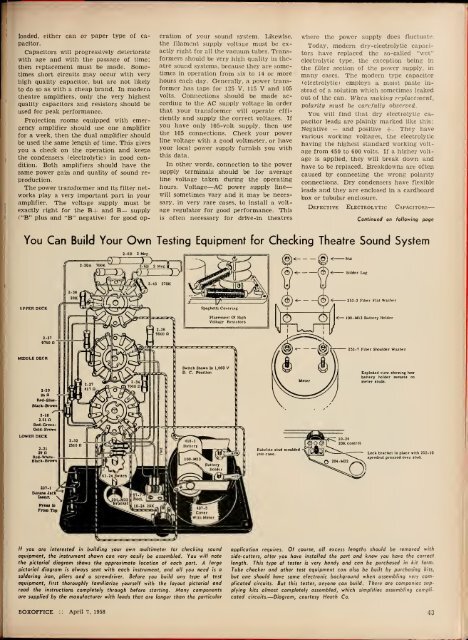Boxoffice-April.07.1958
Create successful ePaper yourself
Turn your PDF publications into a flip-book with our unique Google optimized e-Paper software.
—<br />
'<br />
loaded, either can or paper type of capacitor.<br />
Capacitors will progressively deteriorate<br />
with age and with the passage of time;<br />
then replacement must be made. Sometimes<br />
short circuits may occur with very<br />
high quality capacitor, but are not likely<br />
to do so as with a cheap brand. In modern<br />
theatre amplifiers, only the very highest<br />
quality capacitors and resistors should be<br />
used for peak performance.<br />
Projection rooms equipped with emergency<br />
amplifier should use one amplifier<br />
for a week, then the dual amplifier should<br />
be used the same length of time. This gives<br />
you a check on the operation and keeps<br />
the condensers (electrolytic) in good condition.<br />
Both amplifiers should have the<br />
same power gain and quality of sound reproduction.<br />
The power transformer and its filter networks<br />
play a very important part in<br />
your<br />
amplifier. The voltage supply must be<br />
exactly right for the B+ and B— supply<br />
i"B" plus and "B" negative) for good operation<br />
of your .sound system. Likewise,<br />
the filament .supply voltage must be exactly<br />
right for all the vacuum tubes. Transformers<br />
should be very high quality in theatre<br />
sound systems, because they are sometimes<br />
in operation from six to 14 or more<br />
hours each day. Generally, a power transformer<br />
has taps for 125 V. 115 V and 105<br />
volts. Connections .should be made according<br />
to the AC supply voltage in order<br />
that your transformer will operate efficiently<br />
and supply the correct voltages. If<br />
you have only 105-volt supply, then use<br />
the 105 connections. Check your pKjwer<br />
line voltage with a good voltmeter, or have<br />
your local power supply furnish you with<br />
this data.<br />
In other words, connection to the power<br />
supply terminals should be for average<br />
line voltage taken during the operating<br />
hours. Voltage—AC power supply line<br />
will sometimes vary and it may be necessary,<br />
in very rare cases, to install a voltage<br />
regulator for good performance. This<br />
is often necessary for drive-in theatres<br />
where the power supply does fluctuate.<br />
Today, modem dry-electrolytic capacitors<br />
have replaced the so-called "wet"<br />
electrolytic type, the exception being In<br />
the filter section of the power supply, in<br />
many ca.ses. The modern type capacitor<br />
I<br />
electrolytic employs a moist paste instead<br />
of a .solution which sometimes leaked<br />
out of the can. When making replacement,<br />
polarity must be carelully observed.<br />
You will find that dry electrolytic capacitor<br />
leads are plainly marked like this:<br />
Negative — and positive +. They have<br />
various working voltages, the electrolytic<br />
having the highest standard working voltage<br />
from 450 to 600 volts. If a higher voltage<br />
is applied, they will break down and<br />
have to be replaced. Breakdowns are often<br />
caused by connecting the wrong polarity<br />
connections. Di-y condensers have flexible<br />
leads and they are enclosed in a cardboard<br />
box or tubular enclosure.<br />
Defective Electrolytic Capacitors—<br />
Continued on following page<br />
You Can Build Your Own Testing Equipment for Checking Theatre Sound System<br />
2-6B 2 Meg<br />
:^D—r><br />
UPPER DECK<br />
253-3 Filwr Flal Washer<br />
100-Mt3 Battery Holder<br />
2S3-7 Fiber Shoulder Washer<br />
MIDDLE DECK<br />
Exploded view ahowtng how<br />
battery holder moonts on<br />
meter studs.<br />
LOWER DECK<br />
Lock bra:-ket lo place wttb 252-10<br />
speednut pressed over stud.<br />
If you are interested in building your own multimeter for checking sound<br />
equipment, t/ie instrument shown can very easily be assembled. You will note<br />
the pictorial diagram shows the approximate location of each part. A large<br />
pictorial diagram is always sent with each instrument, and all you need is a<br />
soldering iron, pliers and a screwdriver. Before you build any type of test<br />
equipment, first thoroughly familiarize yourself with the layout pictorial and<br />
read the instructions completely through before starting. Many components<br />
are supplied by the manufacturer with leads that are longer than the particular<br />
application requires. Of course, all excess lengths should be removed with<br />
side- cutters, after you have installed the part and know you have the correct<br />
length. This type of tester is very handy and can be purchased in kit form.<br />
Tube checker and other test equipment can also be built by purchasing kits,<br />
but one should have some electronic background when assembling very complicated<br />
circuits. But this tester, anyone can build. There are companies supplying<br />
kits almost completely assembled, which simplifies assembling complicated<br />
circuits.— Diagram, courtesy Heath Co.<br />
BOXOFFICE :<br />
: April 7, 1958 43

















